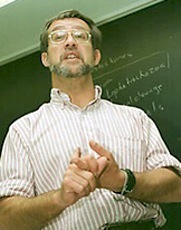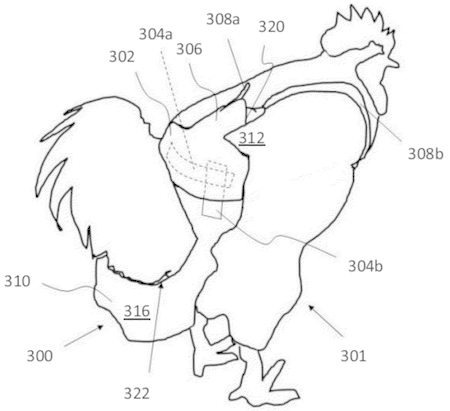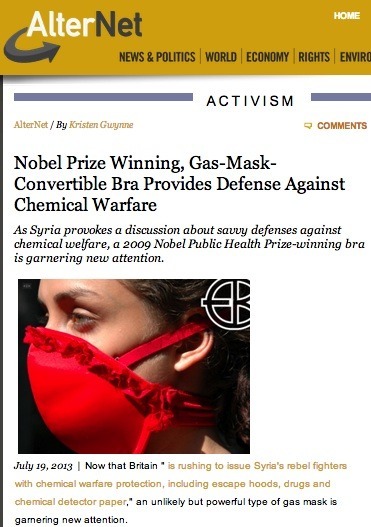Marc Abrahams's Blog, page 476
July 24, 2013
A test of your sense of lingo & jargon
Think you know your physics lingo and jargon? Then see how you do with arXiv vs snarXiv.
BACKGROUND: General information about arXiv




Chicken chicken chicken subways subways subways
Some say chicken chicken chicken, others say subway, subways, subways. Chicken Chicken Chicken Chicken (the academic study) by Doug Zongker, published in the Annals of Improbable Research, vol. 12, no. 5, September-October 2006, led to Chicken Chicken Chicken (the lecture by Zongker, given as part of the Annals of Improbable Research session at that year’s Annual Meeting of the American Association for the Advancement of Science):
The reasoning behind Subways Subways Subways is a bit more complex. The lecturer is Toronto mayor Rob Ford:
BONUS: Subway Chicken
BONUS: Buffalo buffalo etc.
BONUS: Diapers for domestic chickens (Part 1 and Part 2)




Adams apples : examinations (part 1)
 Apparently, the artist Norman Rockwell (1894-1978) was embarrassed by the size of his laryngeal prominence. Mr. Rockwell felt, it’s said, that his Adam’s apple protruded unduly, and had been known to take steps to cover it up in public. [pictured right]
Apparently, the artist Norman Rockwell (1894-1978) was embarrassed by the size of his laryngeal prominence. Mr. Rockwell felt, it’s said, that his Adam’s apple protruded unduly, and had been known to take steps to cover it up in public. [pictured right]
But possible academic implications of this have remained largely unstudied in scholarly circles – until now. Donald Capps,  Princeton Theological Seminary’s William Harte Felmeth Professor of Pastoral Theology, [pictured left] examines Rockwell’s apple in the Feb. 2013 edition of the journal Pastoral Psychology. ‘The Embarrassing Adam’s Apple, Compromised Masculinity, and Hope: The Case of Norman Rockwell’
Princeton Theological Seminary’s William Harte Felmeth Professor of Pastoral Theology, [pictured left] examines Rockwell’s apple in the Feb. 2013 edition of the journal Pastoral Psychology. ‘The Embarrassing Adam’s Apple, Compromised Masculinity, and Hope: The Case of Norman Rockwell’
The focus of the paper is informed by :
“ … a discussion of the Adam’s apple from a historical and medical point of view, and by a consideration of Rockwell’s work as an artist. The article concludes with an exploration of his painting Freedom of Speech and its role in his turning of a perceived physical liability into a psychological strength and of its implications for a view of Rockwell as an agent of hope.”
As well as the Adam’s apple, the professor has also written (in previous publications) about the heart, the nose, the brain, the reproductive organs, the eye, hair and the liver :
“I suggested that there is considerable merit in the early Hebrews’ view that the soul is located in the liver (because the liver is self-regenerative) … “
BONUS 1
Here is the professor’s drawing showing “The model of the Person” (in: Capps, D. ‘A time to Laugh’, 2005)
BONUS 2 : The professor, who was the founder of the Bad Poets Society at Princeton Theological Seminary also writes poetry himself (under the nom-de-plume of Thor Engval) e.g. : “I Lanced a Lot and I’m Sure Thor” (in : Capps, D. Trees and Us: Poetic Metaphors and Pastoral Images. Pastoral Psychology, 60, 437–449.) which examines whether “The sword is mightier than the pen is” [extract]
“I leapt to my feet and raced up the hill
To the place where the Goddess had taken her spill.
As I ran to give aid my rusty old lance
Got jammed down the leg of my Norse Army pants.
What befelleth me next is a sad tale of woe.
Oh, if only the lance had sliced my big toe!”
COMING SOON : Remedies for laryngeal prominences




July 23, 2013
The Fanciful Number 2.9013, Plus or Minus Nothing
Ig Nobel Prize (psychology, 2012) winner Rolf Zwaan writes, in his blog, about the vaunted — yet uncertain — value of a particular number:
The Fanciful Number 2.9013, Plus or Minus Nothing
Can we capture any aspect of human psychology in a single number?
In 1956 a paper entitled The Magical Number Seven Plus or Minus Two saw the light. It was destined to become a classic in cognitive psychology. In it, George A. Miller argued that human short-term memory is limited to seven units of information. The 7 was just an approximation, which is why Miller added the cautious plus-or-minus-two…. Miller’s proposal is modest…. not claimed to be exact [, and] derived in a straightforward way from the data.
There is another number in psychology that makes a lot less sense: the number 2.9013. It represents the ratio between positive emotions and negative emotions that an individual or a group expresses within a given period of time. How did this number get to be so exact, with no less than four decimals? I mean it’s not 3 plus or minus 2 but it’s exactly 2.9013! The number is based on a set of differential equations used to model fluid dynamics.
According to a paper by Frederickson and Losada (2005) there is a tipping point in the ratio between positive and negative emotions.… There is only one problem. The math… has recently been demonstrated by Brown and colleagues to be entirely fanciful....




Diapers for modern domestic chickens (part 2)
Tobi Kosanke, Ph.D., inventor of a diaper for domestic chickens (profiled here yesterday), has filed a patent application for that device:
“Poultry Harness Diaper,” US patent application 20120037094 A1, by Tobi Kosanke, filed August 11, 2011.
“A diaper assembly for use on a bird includes an upper-body portion that has at least one first part of at least one couple assembly attached thereto. The diaper assembly also includes at least one shoulder strap with a first end coupled to the upper-body portion and a second end opposite the first end and a waste receiver that has a waste-catching pouch at least partially defined by a front-facing portion coupled to the second end of the at least one shoulder strap and a rear-facing portion having at least one second part of the at least one couple assembly. Each second part of the at least one couple assembly is operable to releasably secure at least the rear-facing portion of the waste receiver to the upper-body portion.”
Here is a technical drawing from the patent application:
And here is the inventor, waxing eloquent about one of her other inventions:




July 22, 2013
Diapers for modern domestic chickens (part 1)
This video shows Tobi Kosanke, Ph.D., showing how to use diapers for domestic chickens. These are diapers Dr. Kasanke specially designed, so she says, for chickens that or who live inside modern houses or apartments. The diapers are sold under the brand name Hen Holster. The manufacturer’s web site explains more about them. The site mentions the doing of “rigid research and testing” on this and a related line of products that includes a bra for chickens, and a product for cats.
(Thanks to investigators Spring Schoenhuth and Geri Sullivan for bringing this to our attention.)
BONUS: “Dr. Tobi Kosanke is a Sedimentary Petrologist/Reservoir Quality Specialist with Marathon Oil Company.”

July 21, 2013
Swarms of Riderless Unicycles: research roundup
If you thought that the words ‘Unicycle’ and ‘Swarm’ are rarely found in close proximity to each other, you would be mistaken. In fact, the last few years have seen a great deal of academic effort directed specifically at the possibilities offered by a ‘Swarms of Unicycles’. Here are some recent examples from the many dozens of formally published scholarly studies which feature, in some way or other, swarms of (riderless) unicycles.
• Adaptive fuzzy formation control for a swarm of nonholonomic differentially driven vehicles (2012)
• Self-organization of unicycle swarm robots based on a modified particle swarm framework (2010)
• Connectedness Preserving Distributed Swarm Aggregation for Multiple Kinematic Robots (2008)
• Robust self-organization for swarm robots (2008)
All this has prompted Improbable to endeavour (somewhat) to find out where the idea of swarming unicycles first originated. So far, the earliest concrete example we can find was the paper presented at the 43rd IEEE Conference on Decision and Control, Atlantis, Paradise Island, Bahamas in December, 2004. The work was entitled : Feasibility for Formation Stabilization of Multiple Unicycles in which : “The feasibility problem is studied of achieving a specified formation among a group of autonomous unicycles by local distributed control.”
QUESTION :
Can a group of swarming unicycles be considered a single entity – if so, what should it be called? (Bearing in mind that a unicycle, by definition, can only have one wheel)
NOTE :
The above video of the semi-autonomous self-balancing robotic unicycle is provided courtesy of researcher Daniel Fernández de Velasco, who also builds ‘UFOs’ – shown here:

July 19, 2013
Again, Why Don’t Animals Have Wheels?
 Certain questions keep returning, as if on the edge of a rotating wheel:
Certain questions keep returning, as if on the edge of a rotating wheel:
“Why the Wheels Won’t Go,” Michael LaBarbera [pictured here, without wheels], American Naturalist, Vol. 121, No. 3, March 1983, pp. 395-408. The author, at the University of Chicago, begins:
“Why don’t animals have wheels? Introductory hiology teachers commonly note the lack of rotating structures in biological systems, usually as a starting point to illustrate the restrictions that structure and physiology place on the forms which may arise via natural selection. The question of why animals do not have wheels is part of the professional folklore of hiology; while rarely addressed in the formal scientific literature, every biologist is familiar with the question and has a favorite set of explanations…”
BONUS: Wikipedia takes the question for a spin

Someone at Alternet is confused about a bra
Someone at Alternet is confused about a brassiere and a prize. Really, at least two people there are confused: the person who wrote the report headlined “Nobel Prize Winning, Gas-Mask-Convertible Bra Provides Defense Against Chemical Warfare“, and the editor or editors who handled the article during its gestation and journey on to the Internet. [NOTE, about an hour after we posted our appreciation of their article, Alternet apparently removed their article. But here's a screen capture of what was there:]
Dr. Elena Bodnar and her colleagues, inventors of the emergency bra, were awarded a Ig Nobel Prize — not a Nobel Prize! — in the category of public health, in 2009. The Ig Nobel Prize citation reads: “Elena N. Bodnar, Raphael C. Lee, and Sandra Marijan of Chicago, Illinois, USA, for inventing a brassiere that, in an emergency, can be quickly converted into a pair of protective face masks, one for the brassiere wearer and one to be given to some needy bystander.” [REFERENCE: U.S. patent # 7255627, granted August 14, 2007 for a “Garment Device Convertible to One or More Facemasks.”]
This video shows Dr. Bodnar accepting the prize, and demonstrating the device with assistance from Nobel Laureates Wolfgang Ketterle, Orhan Pamuk, and Paul Krugman, at the 2009 Ig Nobel Prize ceremony:
Dr. Bodnar formed a company that now manufactures the emergency bra, and offers it for sale worldwide.
(Thanks to investigator Jess Zimmerman for alerting us to the Alternet article, and to Will Naughton for suggesting that that article “puts the ‘alter’ in ‘Alternet’”.)

Disgusting toolhandles (studies)
“People will not pick up a tool by the handle if it is physically disgusting.”
This is one of the findings of a research group at the Psychology Department of The College of William & Mary* Virginia, US. Their 2013 study can be viewed here in ‘poster’ format – it’s entitled ‘So close and yet so far away: An effect of disgust on tool and distance perception’
The team not only found that :
“Disgust can influence how a tool is grasped and picked up.”
But also :
“Disgusting tools are seen as closer and must be pushed farther from the observer to be viewed as just within reach.“
Unfortunately (perhaps for reasons of space) the document doesn’t specify exactly what the disgusting material was. But fortunately, another paper by the same team – this time in the Journal of Experimental Psychology: Human Perception and Performance, (submitted). ‘Too close for comfort: Feelings of disgust affect distance perception’ goes into more detail :
“Disgust was evoked by covering the tools in a gross substance.”
“… a visibly thick mixture of Vaseline and hand lotion in equal parts.”
For the benefit of other disgust researchers an alternative disgusting material recipe can be found here :
* Note: That’s King William III and Queen Mary II of England, 1693
“Not many colleges can say they’ve canceled [sic] classes because ‘the British invaded’.”
Also See : Disgust With ‘Disgust’

Marc Abrahams's Blog
- Marc Abrahams's profile
- 14 followers







